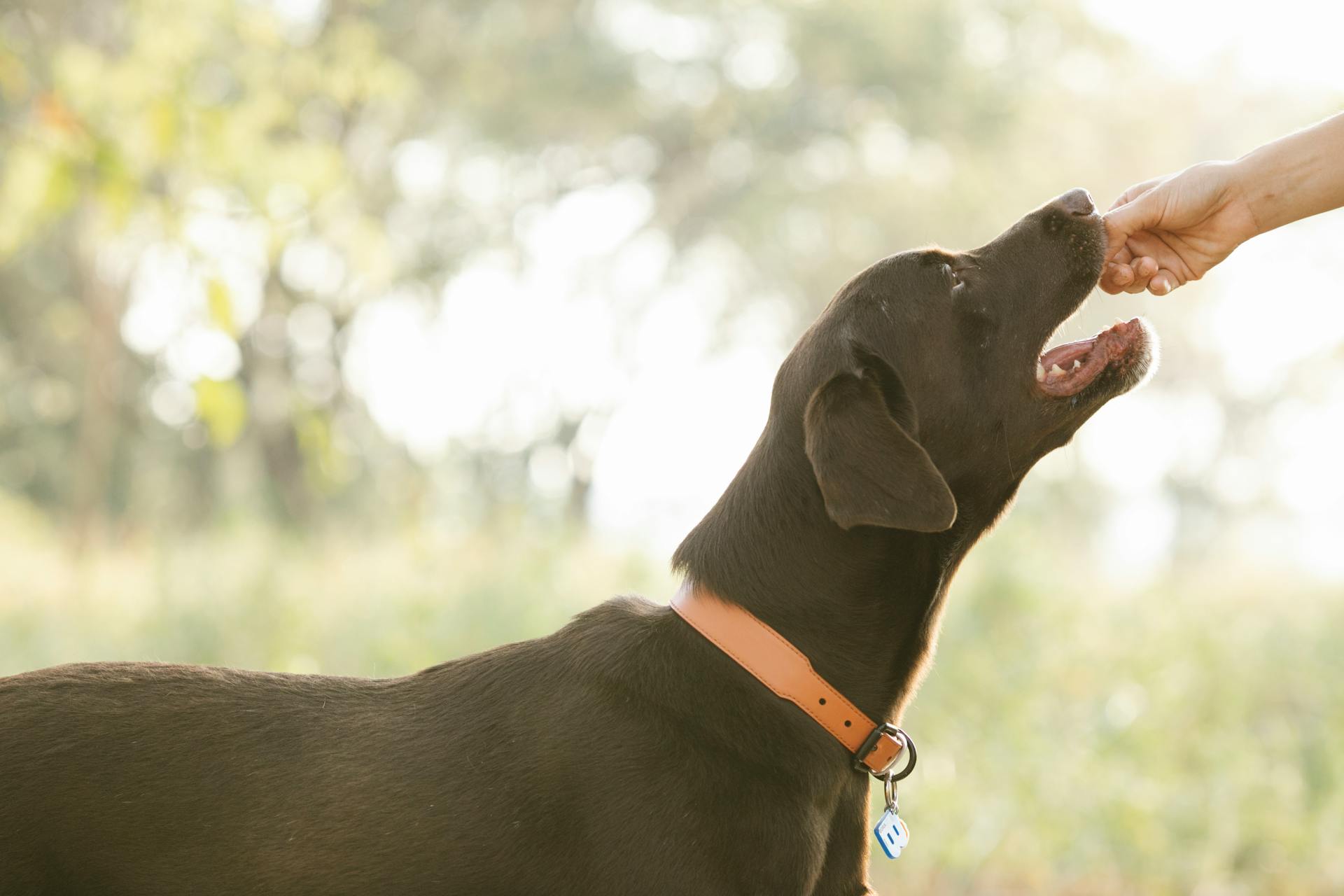
Silver Labradors are often misunderstood, with many people wondering if they're truly purebred or a mix of breeds. This is because their unique silver coat coloration is the result of a genetic variation that's not as common as the traditional black or yellow coats.
The American Kennel Club (AKC) recognizes the Labrador Retriever breed, but they don't have a specific breed standard for silver Labradors. This has led some to question their purity of breed.
To understand the genetic makeup of silver Labradors, we need to look at the genetics behind their coat color. According to our research, the silver coat color in Labradors is caused by a dilution of the black pigment, resulting in a gray or silver appearance.
A different take: Yellow Labrador Coat
Are Silver Labradors Purebred?
The debate about whether silver Labradors are purebred is ongoing, and it's largely centered around the color of their coat. Two theories are heavily debated, but neither has been proven or disproven.
The first theory claims that silver Labradors are pureblooded, with some breeders believing they should be allowed to compete in shows. This theory suggests that the silver color has been present in the breed since its English development in the 19th century.
The theory that silver Labradors are a mixed breed is also popular, with some believing that the Weimaraner breed may have influenced their coat color. This theory suggests that breeders may have inbred silver Labradors to achieve more puppies with the desired color.
One of the main problems with the idea that silver Labradors are purebred is that breeders are not prone to accepting this theory. They point to the fact that the genetics of silver Labradors don't match those of other purebred Labradors.
In fact, the genetics of silver Labradors are so unusual that they are nearly impossible to achieve within the Chocolate Lab bloodlines. This makes it difficult to accept the theory that silver Labradors are purebred.
Here's a breakdown of the genetics of silver Labradors:
- DD genes - Chocolate puppy
- Dd genes - Chocolate puppy
- dd genes - Diluted chocolate or silver puppy
If you're wondering about the health of your silver Labrador, it's worth noting that inbreeding can be a problem. This is because inbred offspring can be more prone to health issues.
To check your dog's DNA and learn more about their genetics, you can use a tool like the Embark Dog DNA Test Kit. This can give you a better understanding of your dog's ancestry and help you identify potential health issues.
Ultimately, the debate about whether silver Labradors are purebred may never be fully resolved. However, by understanding the genetics and health implications of this breed, you can make informed decisions about your dog's care.
Understanding Labradors
Labradors are not typically seen on the field trial circuit because they're not bred for it. This is a key distinction that sets them apart from other types of Labradors.
The temperament of Silver Labradors is a concern, with some veterinarians suggesting they may not be the same as the rest of the Labrador breed. This is based on observations and expert opinions.
Labradors are bred for specific purposes, and their breeding is carefully managed to ensure they meet certain standards. This is in contrast to the breeding of Silver Labradors, which is often done to create a specific color.
The genetics involved in creating Silver Labradors can lead to health problems, according to some experts. This is a potential drawback to breeding for a specific color.
On a similar theme: Breeding Labradors
Mixed Breeds and Genetics
Genes come in pairs, and the D gene, which causes the dilution of the chocolate color, has a dominant and a recessive trait.
The recessive gene is just that - recessive and will always be “overshadowed” by the dominant D gene.
For a puppy to end up with a silver coat, it needs to inherit recessive genes from both parents, which is extremely rare.
Lab Genetics
The genetics of Labradors are complex, especially when it comes to color. The silver color in Labradors is not a pure trait, but rather a dilution of the chocolate color.
To understand this, let's look at the genetics behind it. The D gene is responsible for the dilution of color, and it comes in a dominant and recessive trait. Dominant is labeled as the capital letter D and the recessive as the small letter d.
For a puppy to end up with a silver coat, it needs to inherit recessive genes from both parents, which is extremely rare.
For more insights, see: Labrador Chocolate Color
Here's a simple breakdown of how genetics play out in chocolate Labrador parents:
- DD genes - Chocolate puppy
- Dd genes - Chocolate puppy
- dd genes - Diluted chocolate or silver puppy
This shows that the recessive gene is always "overshadowed" by the dominant D gene, making it difficult for silver Labradors to occur naturally.
Mixed Breed Theory
The Mixed Breed Theory suggests that silver Labradors are a mixed breed, with their coat color influenced by the Weimaraner breed. Before the 1950s, there was barely any mention of silver Labs, which raises questions about their origins.
Kellogg's Kennel started publicly advertising their dogs as silver Labrador puppies for sale, which some argue is the point at which the silver Labrador became a distinct breed. This theory claims that if the color was present in the Labrador breed, we would surely know about it by now.
Inbreeding was necessary to achieve more silver Labrador puppies, which is a term that describes the mating of close relatives to achieve specific physical or psychological characteristics. Inbred offspring can result in health issues connected to mental and physical development.
The Weimaraner breed had to be introduced again to widen the gene pool of silver Labradors, which is a crucial step in avoiding health problems caused by inbreeding.
Suggestion: Types of Yellow Labrador Retrievers
Six Comments
Derrick Spracklin, a commenter, appreciated the factual side of the article, which is a great approach to understanding complex topics like mixed breeds and genetics.
Bruce commented that the article sounds like a seasoned politician, but we can appreciate the passion and conviction behind his words.
Gwenda Davies, a breeder with 23 years of experience, shared her expertise and concerns about the Labrador Retriever breed. She specialized in chocolates and then started a separate line for yellows, with a motto that reflects her dedication to the breed.
Gwenda's experience highlights the importance of breeding for the betterment of the breed, rather than just for profit. She also mentions that some breeders prioritize making a profit over producing high-quality dogs.
Here are some key points from Gwenda's comment:
- She bred Labrador Retrievers for 23 years, with a focus on the love of the breed rather than financial gain.
- She specialized in chocolates and then started a separate line for yellows, with a clear distinction between the two.
- Her motto reflects her dedication to the breed and her commitment to producing high-quality dogs.
Gwenda's comment also touches on the issue of diluting the standard of the breed, which is a concern for many breeders and dog enthusiasts.
Labrador Care and Information
Labrador Retrievers are a popular breed, and for good reason. They're known for their friendly, outgoing personalities and high intelligence.
Labradors require regular exercise to stay happy and healthy, and it's recommended that they get at least 30 minutes of exercise per day. This can be in the form of walks, runs, or playtime in the yard.
Their short coats are easy to maintain, but they do shed heavily twice a year. This means they'll need regular brushing to prevent matting and tangling.
Labradors are generally good with children, but as with any breed, it's essential to socialize them properly from an early age. This will help them become confident and calm around kids.
Labradors are prone to certain health issues, including hip dysplasia and eye problems. Regular check-ups with a veterinarian can help identify these issues early on.
Labradors are highly trainable, and with positive reinforcement, they can learn a wide range of commands and tasks. This makes them a popular choice as both family pets and working dogs.
Take a look at this: Food for Labradors
Frequently Asked Questions
Does AKC recognize silver Labradors?
No, the American Kennel Club (AKC) does not recognize silver as a standard color for Labrador Retrievers. According to an agreement with the Labrador Retriever Club, silver Labs are registered as chocolates due to lack of proof of their purity.
Featured Images: pexels.com


